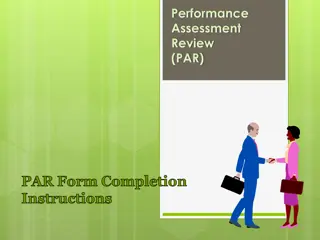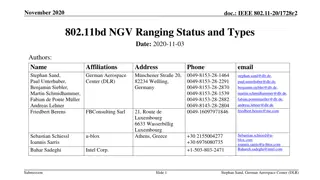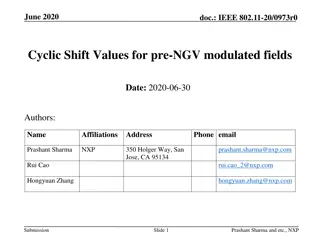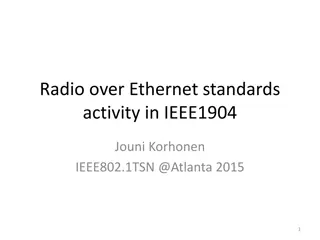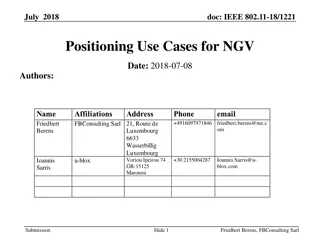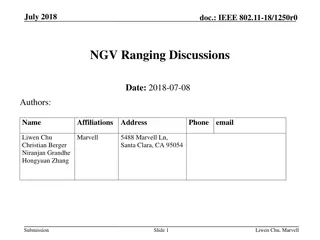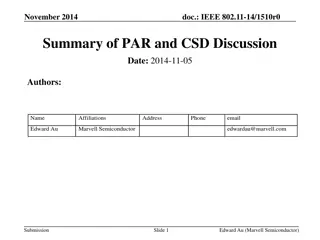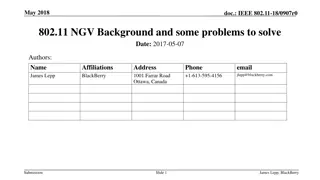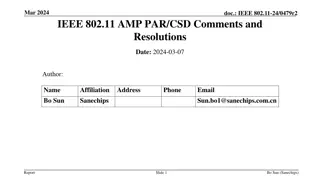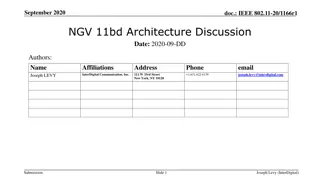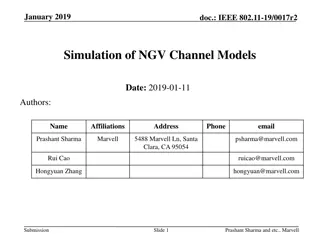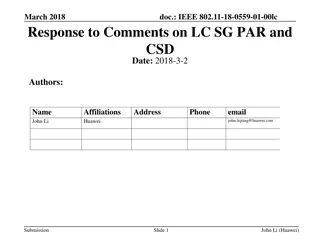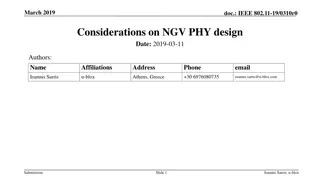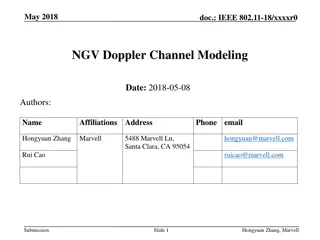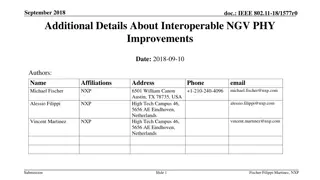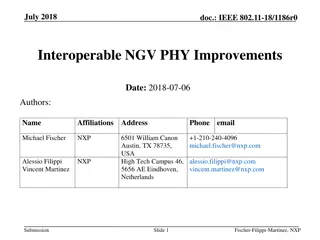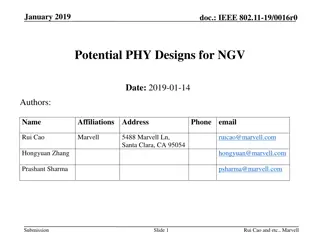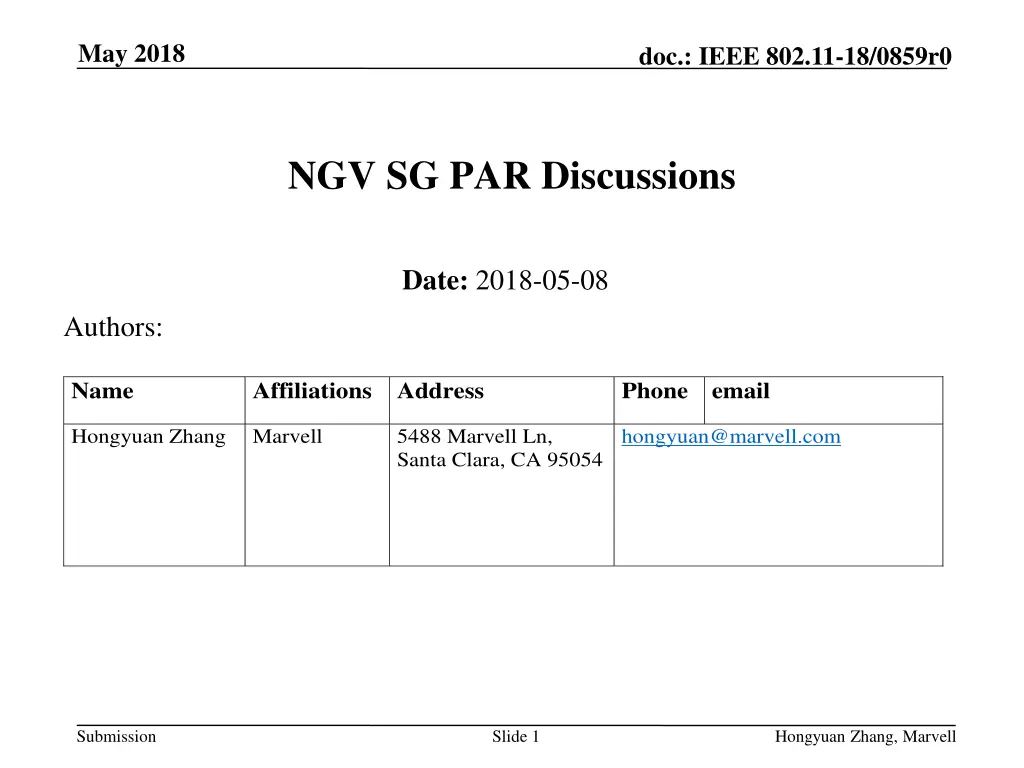
IEEE 802.11-18/0859r0 NGV SG Discussions
Explore the discussions around the IEEE 802.11-18/0859r0 NGV SG PAR proposal focusing on throughput gain, target Doppler speeds, longer range, and operation bands for improved wireless communication technologies. Key points include enhancing throughput in aggressive Doppler environments, setting target Doppler speeds, extending communication ranges, and considering operation bands for NGV PHY. Join the conversation on the future advancements in wireless technologies.
Download Presentation

Please find below an Image/Link to download the presentation.
The content on the website is provided AS IS for your information and personal use only. It may not be sold, licensed, or shared on other websites without obtaining consent from the author. If you encounter any issues during the download, it is possible that the publisher has removed the file from their server.
You are allowed to download the files provided on this website for personal or commercial use, subject to the condition that they are used lawfully. All files are the property of their respective owners.
The content on the website is provided AS IS for your information and personal use only. It may not be sold, licensed, or shared on other websites without obtaining consent from the author.
E N D
Presentation Transcript
May 2018 doc.: IEEE 802.11-18/0859r0 NGV SG PAR Discussions Date: 2018-05-08 Authors: Name Affiliations Address Phone email Hongyuan Zhang Marvell 5488 Marvell Ln, Santa Clara, CA 95054 hongyuan@marvell.com Submission Slide 1 Hongyuan Zhang, Marvell
May 2018 doc.: IEEE 802.11-18/0859r0 Introduction In [1] the motivation of forming NGV SG was stated. A baseline PAR proposal is in doc 11-18-861 [2] Discussion point on Scope session of PAR proposal: Throughput gain Target Doppler (speed) Longer range Operation Band Submission Slide 2 Hongyuan Zhang, Marvell
May 2018 doc.: IEEE 802.11-18/0859r0 1. Throughput Gain over 11p In [3] some PHY feasibility was discussed. To achieve more advanced use cases beyond basic safety, we think that the main goal of NGV is to improve the throughput in the most aggressive Doppler environment. Higher achievable MCS Longer packet length. As shown in [3], by picking some existing PHY technologies in other amendments, in the aggressive Doppler environment we should be able to get ~2x throughput improvement from 11p observed on top of MAC. PAR Scope may state the quantitative throughput gain over 11p in aggressive Doppler environment. Submission Slide 3 Hongyuan Zhang, Marvell
May 2018 doc.: IEEE 802.11-18/0859r0 2. Target Doppler 11p PAR states that: operating at speeds up to a minimum of 200 km/h . CV2X target is vehicle absolute speed of 250km/h, and relative speed of 500km/h. No materialized difference from 11p in real operation. Propose to have the same speed requirement of 250km/h in NGV s PAR scope section. Submission Slide 4 Hongyuan Zhang, Marvell
May 2018 doc.: IEEE 802.11-18/0859r0 3. Longer Range 11p PAR says: for communication ranges up to 1000 meters . Actual range is dependent on Tx output power and Tx/Rx implementations. As analyzed in [1][3], it should be easy to find some low hanging fruits from existing amendments that achieve longer range than 11p. It may not be worthwhile to come up with a detailed range in the PAR, but instead just say longer range than 11p . Submission Slide 5 Hongyuan Zhang, Marvell
May 2018 doc.: IEEE 802.11-18/0859r0 4. Operation Band It is natural to reuse the same band and channelization as DSRC in 5.85~5.925GHz band. There was some discussions [3][4] for protecting the incumbent 11p/DSRC operation in the collision avoidance safety channel (Ch172), which is practically the only channel that 11p devices are deployed. 11p is dedicated for safety and it requires robustness. In PAR should we say NGV PHY is excluded from Ch172? An alternative is not to state channel exclusion in PAR, and leave the discussion to the TG stage. NGV may still introduce multiple-antenna 1SS cases, where it may define the CSD value, so technically NGV PHY spec may still cover Ch172, even if NGV PPDU is disallowed in this channel. Efficient coex method to allow NGV PHY in Ch172? Again, this is likely a TG topic Submission Slide 6 Hongyuan Zhang, Marvell
May 2018 doc.: IEEE 802.11-18/0859r0 SP1 Do you agree that NGV PAR scope defines 2x throughput gain over 11p in the aggressive Doppler channel with highest vehicle operating speed at minimum of 250Km/h ? Submission Slide 7 Hongyuan Zhang, Marvell
May 2018 doc.: IEEE 802.11-18/0859r0 SP2 Which of the following options regarding the operation band in the NGV PAR scope do you prefer: Option-1: PAR Scope states that Ch172 is not in the scope of NGV, and NGV PHY is not allowed in Ch172. Option-2: PAR Scope does not mention channel exclusion within 5.85~5.925GHz band, and leave the discussions in TG stage. Submission Slide 8 Hongyuan Zhang, Marvell
May 2018 doc.: IEEE 802.11-18/0859r0 Reference [1] Hongyuan Zhang et. al., 802.11 For Next Generation V2X Communications , IEEE 802.11-18/0513r2. [2] Hongyuan Zhang et. al., 11-18-0861-00-0ngv-IEEE-802.11-NGV-SG-Proposed- PAR [3] Hongyuan Zhang et. al., 11-18-0860-00-0ngv-NGV-PHY-Feasibility-Discussions [4] Onn Haran, et. al., 11-18-0xxx-00-0ngv-802.11ngv-High-level- Requirements Submission Slide 9 Hongyuan Zhang, Marvell

